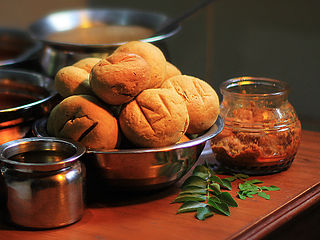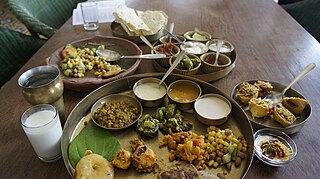
Chapati, also known as roti, rooti, rotee, rotli, rotta, safati, shabaati, phulka, chapo, sada roti, poli, and roshi, is an unleavened flatbread originating from the Indian subcontinent and is a staple in India, Nepal, Bangladesh, Pakistan, Kyrgyzstan, Sri Lanka, the Arabian Peninsula, East Africa, and the Caribbean. Chapatis are made of whole-wheat flour known as atta, mixed into dough with water, oil (optional), and salt (optional) in a mixing utensil called a parat, and are cooked on a tava.

Roti is a round flatbread originating from the Indian subcontinent. It is commonly consumed in many South Asian, Southeast Asian, Caribbean, and Southeast African countries.

Bhakri is a round flatbread often eaten in the cuisines of the states of Maharashtra, Gujarat, Rajasthan, and Karnataka in India. Bhakri is prepared using jowar or bajra, which is coarser than a regular wheat chapati. Bhakri can be either soft or hard in texture, unlike khakhra in respect to hardness.

A dhaba is a roadside restaurant in the Indian subcontinent. They are on highways, generally serve local cuisine, and also serve as truck stops. They are most commonly found next to petrol stations, and most are open 24 hours a day.

Rajasthani cuisine is the traditional cuisine of the Rajasthan state in north-west India. It was influenced by various factors like the warlike lifestyles of its inhabitants, the availability of ingredients in an arid region and by Hindu temple traditions of sampradayas like Pushtimarg and Ramanandi. Food that could last for several days and could be eaten without heating was preferred.

Puri, also poori, is a type of deep-fried bread, made from unleavened whole-wheat flour, originated from the Indian subcontinent.

Puran poli is an Indian sweet flatbread that is popular in South India and the state of Maharashtra. It is also known as puran puri, holige, obbattu, bobbatlu, poley, bakshamulu, and boli.

Baati is a hard, unleavened bread cooked in most areas of Rajasthan, and in some parts of Madhya Pradesh and Gujarat states of India. It is prized for its long shelf life and high nutritional content, and, in desert areas, for the minimal quantity of water required for its preparation. Baati is commonly eaten with dal, hence also referred to as dal baati. In some regions, especially Madhya Pradesh, it is also paired with a roasted aubergine mash called bharta. Baati is also closely related to Litti (cuisine), popular in eastern Uttar Pradesh (Varanasi) and western Bihar. Litti is eaten with potato, tomato and roasted aubergine.

Gujarati cuisine is the cuisine of the Indian state of Gujarat. The typical Gujarati thali consists of rotli, dal or curry, rice, and shaak. The thali will also include preparations made from pulses or whole beans such as moong, black eyed beans etc., a snack item (farsaan) like dhokla, pathra, samosa, fafda, etc. and a sweet (mishthaan) like mohanthal, jalebi, sevaiya etc.

Indian breads are a wide variety of flatbreads and crêpes which are an integral part of Indian cuisine. Their variation reflects the diversity of Indian culture and food habits.

Kadhi or karhi is a yogurt-based dish originating from the Indian subcontinent. It is made by simmering yogurt with besan and Indian spices until it forms a thick, tangy gravy. Sometimes, it is also mixed with pakoras. It is often eaten with cooked rice or roti.
Dal Bati Churma is the most popular dish in the Rajasthani cuisine of India. It is made up of three components of bati, dal, and churma. Dal is lentils, bati is a baked wheat ball, and churma is powdered sweetened cereal. Churma is a popular delicacy mostly served with baatis and dal. It is coarsely ground wheat crushed and cooked with ghee and sugar. Traditionally it is made by mashing up wheat flour baatis or left over rotis in ghee and jaggery.
Bhojpuri cuisine is a style of food preparation common among the Bhojpuri people of Bihar, Jharkhand and eastern Uttar Pradesh in India, and also the Terai region of Nepal. Bhojpuri foods are mostly mild and tend to be less hot in terms of spices used. The cuisine consists of both vegetable and meat dishes.
Bihari cuisine is eaten mainly in the eastern Indian state of Bihar, as well as in the places where people originating from the state of Bihar have settled: Jharkhand, Eastern Uttar Pradesh, Bangladesh, Nepal, Mauritius, South Africa, Fiji, some cities of Pakistan, Guyana, Trinidad and Tobago, Suriname, Jamaica, and the Caribbean. Bihari cuisine includes Angika cuisine, Bhojpuri cuisine, Maithil cuisine and Magahi cuisine. Dal Puri

Andhra cuisine, culturally known as Telugu cuisine, is a cuisine of India native to the state of Andhra Pradesh and is the culinary style of Telugu people. It is generally known for its tangy, hot, and spicy taste.

Malaysian Indian cuisine, or the cooking of the ethnic Indian communities in Malaysia, consists of adaptations of authentic dishes from India, as well as original creations inspired by the diverse food culture of Malaysia. Because the vast majority of Malaysia's Indian community are of South Indian descent, and are mostly ethnic Tamils who are descendants of immigrants from a historical region which consists of the modern Indian state of Tamil Nadu and Sri Lanka's Northern Province, much of Malaysian Indian cuisine is predominantly South Indian-inspired in character and taste. A typical Malaysian Indian dish is likely to be seasoned with curry leaves and whole and powdered spice, and to contain fresh coconut in various forms. Ghee is still widely used for cooking, although vegetable oils and refined palm oils are now commonplace in home kitchens. Before a meal it is customary to wash hands as cutlery is often not used while eating, with the exception of a serving spoon for each respective dish.

Daal bati is an Indian dish of dal (lentils) and bati. It is popular in Rajasthan, Madhya Pradesh, Maharashtra's Khandesh and Vidarbha region, Gujarat, and Uttar Pradesh.
Cuisines and food of the Indian state of Haryana is known to be simple. People of the state prefer their food to be made with fresh ingredients and through simple recipes. Roti is a staple food in Haryana, made from a variety of grains and flour. Since Haryana is rich with agriculture and cattle, the use of dairy products is abundant in their food. Many households churn fresh butter from milk and use it as opposed to the butter available in the markets. Lassi is a popular and staple drink in Haryana. The food in Haryana finds a lot of similarities with its neighboring states Punjab and Rajasthan.
Consumption of non-vegetarian food is generally avoided in the state and sometimes is even considered a taboo among the rural population.
Katt Bafla is a popular and traditional dish from the Kota, Bundi districts of Hadoti region in Rajasthan, India. It is a famous dish across the north Indian states in India. Traditionally this dish is made on every occasion in Rajasthan. In this dish Bafla is a type of spherical wheat bread whereas the Katt is a type of Barfi made with a mixture of unsalted wheat bread coarse powder with ghee and jaggery powder. Traditionally this dish is served with Daal and Kadhi.













